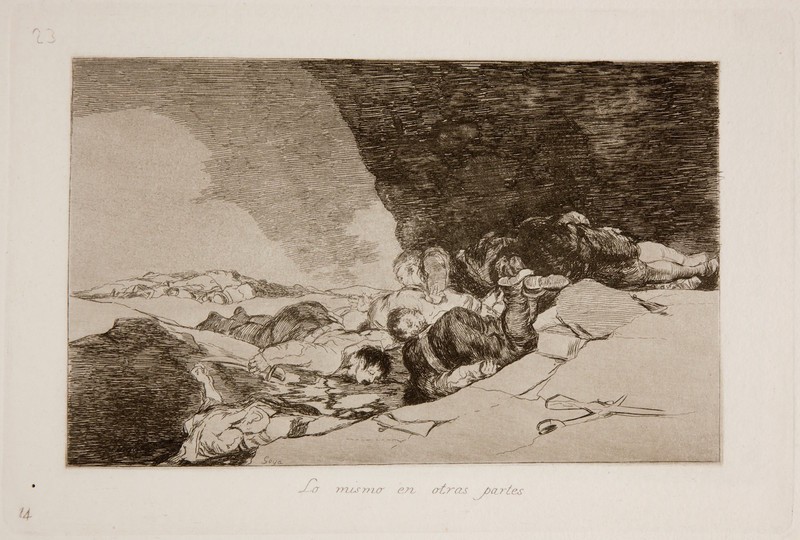- Cronología
- Ca. 1810 - 1812
- Dimensiones
- 162 x 240 mm
- Técnica y soporte
- Etching, lavis, drypoint and burin
- Reconocimiento de la autoría de Goya
- Undisputed work
- Ficha: realización/revisión
- 01 Dec 2010 / 28 Oct 2022
- Inventario
- 225
Signed Goya (lower left-hand corner), 14 (lower left-hand corner).
See Sad presentiments of what must come to pass.
There is a third artist's proof that predates the writing and numbers added later. It bears signatures on the lower left-hand corner.
The title was handwritten on the print by Goya in the first and only series that is known to have been printed at the time the works were created, which the artist gave to his friend Agustín Ceán Bermúdez. Therefore, the title was etched into the plate at a later date and left unchanged as of the first edition of the Disasters of War printed by the San Fernando Royal Academy of Fine Arts in Madrid in 1863, after the printing of the series in the possession of Ceán Bermúdez.
There is a surviving preparatory drawing for this print which is housed in the Prado Museum in Madrid.
A large number of corpses lie within a cave. Some of the figures still hold weapons in their hands and are still dressed, from which we can deduce that their deaths happened only a short time ago. The violent postures of the bodies and their facial expressions - some of the figures' mouths are open - accentuate the horror of the scene. The atmosphere of the scene is spectral, and it is clear that the bodies have not been discovered as yet.
Goya has made great use of etching techniques in the case of this print, creating short, horizontal lines that serve to capture the huge rock on the right-hand side of the composition that suggests the wall of the cave.
This print continues the series of images begun in prints no. 21, It Will Be the Same and nº 22, All This and More in which the corpses have the central role, depicted as human remains devoid of any dignity.
The artist has used the device of a cave in other works such as those depicting cannibals Cannibals Preparing their Victims. In those cases the space serves to create a different kind of atmosphere, with the cave represented as a place that shelters man and protects him - even in the case of the cannibals. In this print, however, the cave has not protected those who now lie dead within it.
The plate is stored in the National Chalcography (cat. 274)
-
Goya and his timesThe Royal Academy of ArtsLondon1963cat. 66cat. 239
-
Francisco de GoyaMuseo d'Arte ModernaLugano1996exhibition celebrated from September 22nd to November 17th.cat. 23
-
Francisco Goya. Sein leben im spiegel der graphik. Fuendetodos 1746-1828 Bordeaux. 1746-1996Galerie KornfeldBern1996from November 21st 1996 to January 1997cat. 111
-
Francisco Goya. Capricci, follie e disastri della guerraSan Donato Milanese2000Opere grafiche della Fondazione Antonio Mazzottacat. 103
-
Goya. Opera graficaPinacoteca del Castello di San GiorgioLegnano2006exhibition celebrated from December 16th 2006 to April 1st 2007p. 62
-
Goya en tiempos de guerraMuseo Nacional del PradoMadrid2008consultant editor Manuela B. Mena Marqués, from April 14th to July 13th 2008cat. 23
-
Goya et la modernitéPinacothèque de ParisParís2013from October 11st 2013 to March 16th 2014cat.62
-
Goya, grabadorMadridBlass S.A.1918cat. 125
-
Goya engravings and lithographs, vol. I y II.OxfordBruno Cassirer1964cat. 143
-
Vie et ouvre de Francisco de GoyaParísOffice du livre1970cat. 1031
-
Catálogo de las estampas de Goya en la Biblioteca NacionalMadridMinisterio de Educación y Cultura, Biblioteca Nacional1996cat. 222
-
ParísPinacoteca de París2013p. 131
-
Goya. In the Norton Simon MuseumPasadenaNorton Simon Museum2016pp. 114-151

